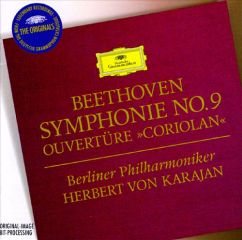Beethoven – Coriolan & Symphony No.9 (Karajan) [1962]
Beethoven – Coriolan & Symphony No.9 (Karajan) [1962]

1. - Overture "Coriolan", Op.62 9:00
Symphony No. 9 in D minor ("Choral"), Op. 125
2. - 1. Allegro ma non troppo, un poco maestoso 15:29
3. - 2. Molto vivace 11:00
4. - 3. Adagio molto e cantabile 16:26
5. - Presto 6:22
6. - Presto - "O Freunde, nicht diese Töne!" - Allegro assai 17:33
Gundula Janowitz – soprano
Waldemar Kmentt – tenor
Hilde Rossel-Majdan – alto, contralto
Walter Berry – bass
Wiener Singverein
Berlin Philharmonic Orchestra
Herbert von Karajan – conductor
By any measure this is one of the greatest Beethoven Ninths on disc. The quality of the interpretation hasn't been well stated in the reviews here, however. Karajan in 1962 wanted to perform Beethoven in a modern way compared to the overtly spiritual, often very slow, heavy, and rubato-laden style of the past in Germany. This recording is a lyrical Ninth in many ways: the entire slow movement is lightly voiced and songful, and in the last movement Karajan takes the vocal line faster and with more smoothness, less effort than usual. By comparison, Karajan wasn't as hectically fast or intense as Toscanini, not as straight-faced and diect as Weingartner, not as willful and overplayed as Stokowski, not as granitic and solemn as Klemperer. He was finding his own way, and being the master conductor of the age, his aproach is fascinating in every bar. The overall impression is a natural arc moving from the mystery of the opening bars to the palpable joy and reverence of the finale. In this respect his 1962 Ninth is unique.
Now as to the sound. The chorus is very large and remotely placed, which can make it sound diffuse but not murky or muffled as some have claimed. The winds are recorded forward of the strings rather than in their midst. As with many mono recordings, the mike placement gives the perspective, not of a front-row seat, much less a conductor's x-ray perspective, but a middle-row--this means that there is much less highlighting of solos than we are used to from digital recordings and multi-microphones. The blending of voices is more obvious here, especially in the woodwinds. That's all I wanted to point out. Whether this Ninth is the "greatest" is a bit of a pointless contest, but its excellence is undeniable. --- Santa Fe Listener, amazon.com
download: uploaded anonfiles mega 4shared mixturecloud yandex mediafire ziddu








